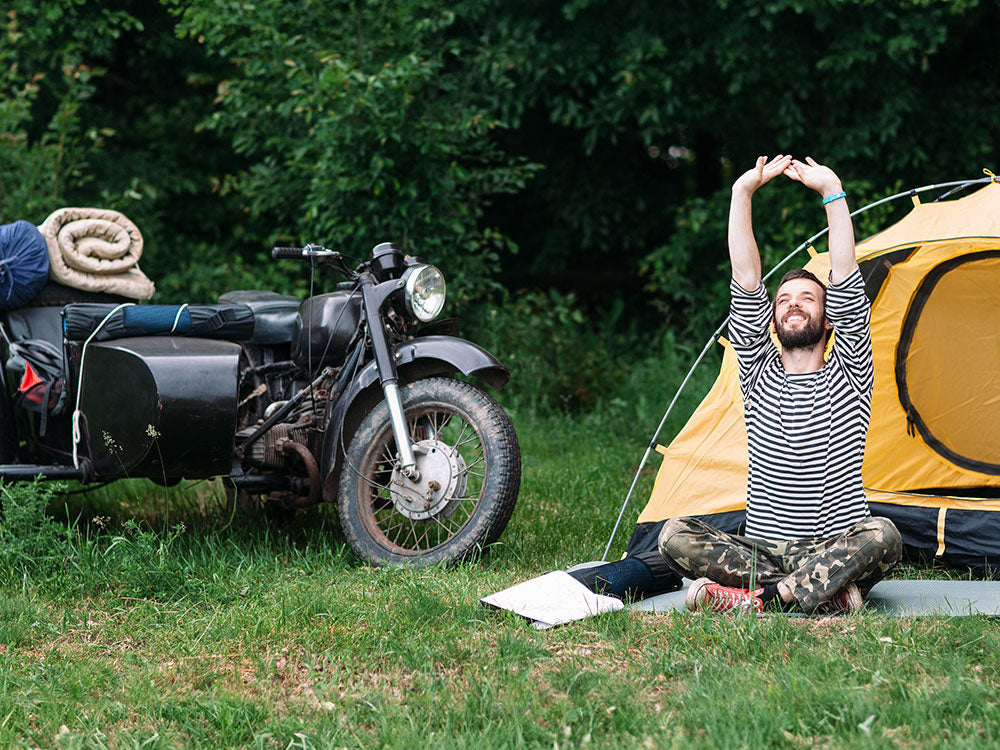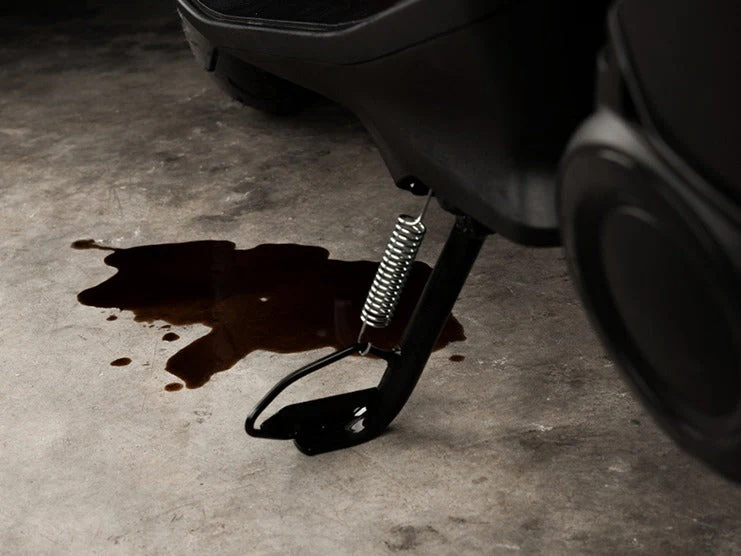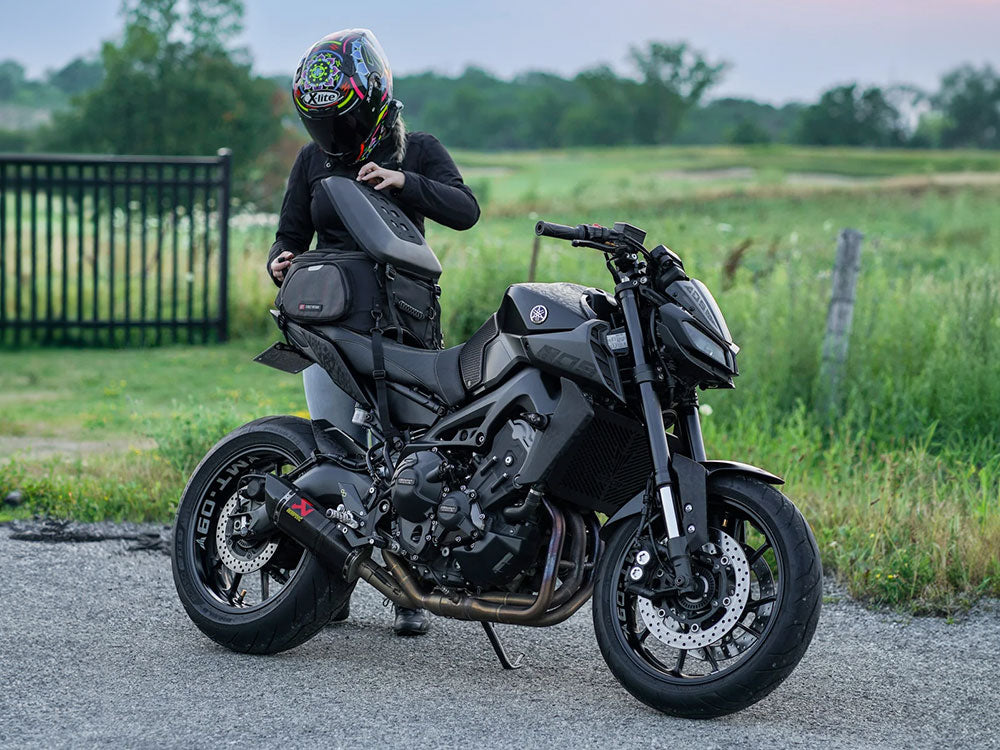Stretching before a track day is beneficial for motorcycle riders. Stretching will reduce the likelihood of pulling a muscle, improve flexibility, reduce the likelihood of suffering cramps, improves blood circulation, and offers a more relaxed and comfortable riding position.
Below are easy and quick stretching workouts for motorcycle riders to perform before a track day.
Table of Content

1. Lat Stretch
For motorcyclists, their shoulders are often worked the hardest. Prolonged forward flexion during motorcycle riding can tighten the muscles and shorten the tendons and ligaments.
How to Do:
- Put your left hand behind your neck and take it as far down the right shoulder blade as you can.
- Gently pull on your left elbow with your right hand until you feel resistance.
- Repeat five times on both sides.
2. Hamstring Stretch
The most crucial part of the hamstring stretch is maintaining the hamstring's elasticity. Stretching the hamstrings helps improve the hip's range of motion and flexibility.
How to Do:
- Standing with your legs straight and your feet shoulder-width apart, relax your neck as you slowly reach for your toes.
- Reach for your toes as far as you can. Afterward, carefully raise and straighten your back, raising your arms above your head.
- Repeat 8-10 times.
3. Cat-Cow Stretch
The cat-cow stretch can help riders improve flexibility in their necks, shoulders, and spines. This exercise stretches the chest, back, abdomen, and hips muscles. The tailbone is engaged during this stretch, helping to relax the upper back and neck.
How to Do:
- Kneel on the ground, keeping your hands close to your sides and your shoulders above them.
- Pull your chest away from the floor while keeping your shoulders set while you assume the "cat" pose. For three to five seconds, maintain the "cat" pose.
- Allow your hips to fall toward the floor and arch your lower back until you adopt the "cow" pose.
- Return to the neutral position while flexing your core muscles.
- Repeat 8-10 times.
4. Cobra Stretch
The cobra stretch improves spinal flexibility, posture, and alignment. Moreover, it opens the lungs, improves blood circulation, and reduces back pain.
How to Do:
- Place your palms apart at shoulder width on the floor while resting on your stomach.
- Keep your hip in contact with the floor while pushing into the ground and extending your elbows.
- As you arch your back as far as possible, relax your butt while keeping your elbows close to your sides.
- Hold each stretch for 10 seconds as you repeat 8-10 times.
5. Open Book Stretch
Open book stretching is a great way to increase spinal mobility, especially in the thoracic area. This is also a fantastic exercise for shoulder mobility and chest opening.
How to Do:
- Lay on your side with your top leg at a 90-degree angle and your bottom leg kept straight.
- Press your open palms together and extend your arms in front of you.
- Raise your upper arm and rotate it over your chest while rotating your head in the same direction.
- Repeat 8-10 times on both sides.
6. Child Pose Stretch
The child pose stretch is the best way to relieve back muscles, increase blood flow in your neck and head, stretch the ankles and spine, and stimulate your digestive system.
How to Do:
- Get down on all fours.
- Rest your butt above your feet while still on your knees.
- Push your knees apart while making sure your toes remain in contact.
- Reaching forward along the floor, tuck your butt down toward your heels.
- Place your head on the floor and your chest between your knees.
- While stretching as far as you can, extend your arms to one side, then the other.
- Hold each position for 30 seconds and repeat three times.
7. Windmill Stretch
The windmill stretch is another simple shoulder workout. Due to the intricate anatomy of the shoulder muscles and tendons and the prevalence of rotator cuff injuries, it is important to properly warm up these muscles and tendons before engaging in any strenuous activity.
How to Do:
- Starting by maintaining a comfortable distance between your arms and torso while rotating each arm through its entire range of motion.
- For this workout, fluidity, and control of your motions are more important than speed.
- Fix your gaze on a fixed spot straight ahead to keep your head steady.
8. Broomstick Stretch
Regardless of the type of riding you do, you'll use your lower back and abdominal muscles much more than you may think. The broomstick stretch will help reduce aches and pains while keeping the lower back and abdominal muscles flexible and strong.
How to Do:
- Support your arm with a broom while standing straight with your feet shoulder-width apart.
- Spin from the hips until you feel resistance, but be careful not to overextend.
- Keep your neck relaxed by concentrating on your hands while you spin from left to right.
- Repeat 8-10 times.
9. The Roll Stretch
The roll stretch helps relieve muscle soreness, tightness, and inflammation and can also increase the range of motion in your joints.
9.1 Pec Stretch (Static Hold)
- Lay down on the roll on your back. Make sure that your tailbone and head are well supported.
- Spread your arms straight on the ground and stretch until you feel a mild to moderate pulling sensation.
- Hold for a minimum of 30 seconds.
9.2 Heel Reach (Dynamic Stretching)
- Lie on your back on top of the foam roll with your palm facing up along the sides of the roll.
- Make sure your lower arms touch the ground as much as possible.
- Reach towards your heel in slow motion and maintain a gentle, rhythmic motion.
- Perform this exercise for one minute.
9.3 Swim (Dynamic Stretching)
- Lie down atop a foam roll. Raise one arm straight above your head and the other arm pointed straight down along your side.
- Relax your elbow when your arm gets close to your head.
- Change the positions of your arms and repeat.
- Perform this exercise for one minute.
9.4 Butterfly (Dynamic Stretching)
- Lie down atop a foam roll and place both hands under the part of the neck that doesn’t make contact with the roll and interlock your fingers behind the neck.
- Gently move your elbows up and down at a steady rhythm.
- Perform this exercise for one minute.
10. Forearm Stretch
Many riders suffer from tingling, numbness, and elbow pain while riding. Regular forearm stretches can help reduce the occurrence of these afflictions.
10.1 Extensor Stretch
- Bend your wrist and point your fingers toward the ground with your elbow locked and shoulder relaxed.
- Use your other hand gently to put a little pressure on the backside of your hand.
- Keep stretching until you feel a pulling sensation on the back of your wrist and the top of your forearm.
- Hold for at least 30 seconds on both sides.
10.2. Flexor Stretch
- Bend your wrist and point your fingers toward the sky with the elbow locked and shoulder relaxed.
- Use the other hand to apply a little pressure on the palm side of your hand.
- Keep stretching until you feel a mild pulling sensation on the bottom of your wrist and forearm.
- Hold for at least 30 seconds on both sides.
11. Benefits of Stretching Exercises for Motorcycle Riders
11.1 Heals and Prevents Back Pain
Riding a motorcycle with back pain can make it difficult for riders to handle their bike. Consider stretching before hitting the track. Tight muscles can cause a decrease in your range of motion. When this happens, the muscles in your back can become strained. Stretching can heal back pain by pulling the muscles. A regular stretching routine can reduce the risk of muscle strain and prevent back pain by strengthening your back muscles.
11.2 Reduces Stress
Most motorcycle riders are stressed about their performance before the track day which can cause the muscles to tighten. Stretching can help relieve muscle tension and ensure a comfortable, stress-free ride.
11.3 Improves Posture
Poor body posture can negatively affect your performance. Stretching specific muscle groups can help encourage proper alignment and reduce musculoskeletal pain, which in turn improves your body posture.
11.4 Increases Blood Flow
Regular stretching exercises improve blood circulation, which increases blood flow to the muscles, and helps reduce muscle tightening and soreness.
11.5 Increases Range of Motion
On a track day, being unable to move a joint could be bad for a rider. Having the freedom of movement and a full range of motion will improve your confidence during a ride. Stretching can be beneficial in this regard. When it comes to increasing your range of motion, static and dynamic stretching are effective means.
11.6 Increases Flexibility
Flexibility is crucial for overall health and can be increased by stretching regularly. Improved flexibility will help you perform better and suffer less fatigue.
12. Last Words
Before a track day, riders must have improved flexibility, relaxed muscles, better posture, and increased blood flow. Stretching workouts can benefit riders by helping improve their range of motion, relax their muscles, and decrease the risk of injury. You can improve your motorcycle’s look by adding new Saddlebags, crash bars, fairings, handlebars, and sissy bars.













Leave a comment
All comments are moderated before being published.
This site is protected by hCaptcha and the hCaptcha Privacy Policy and Terms of Service apply.